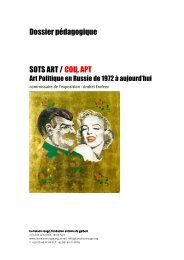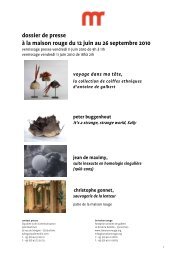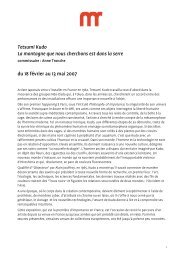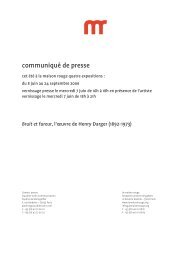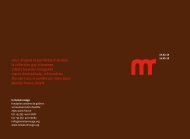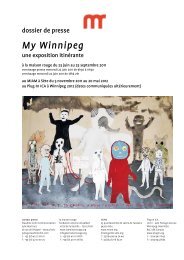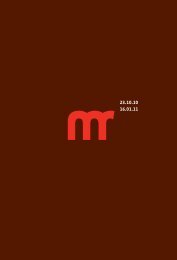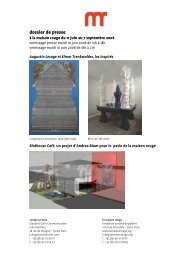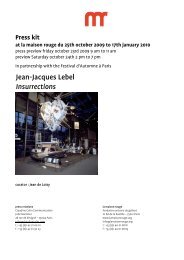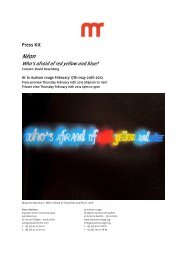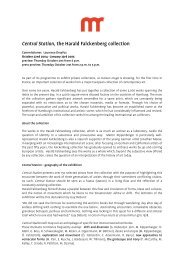press release phora, Ann Hamilton exhibition - La maison rouge
press release phora, Ann Hamilton exhibition - La maison rouge
press release phora, Ann Hamilton exhibition - La maison rouge
Create successful ePaper yourself
Turn your PDF publications into a flip-book with our unique Google optimized e-Paper software.
<strong>press</strong> <strong>release</strong><br />
<strong>phora</strong>, <strong>Ann</strong> <strong>Hamilton</strong> <strong>exhibition</strong><br />
curator: Waltraud Forelli-Wallach<br />
February 18th – May 22nd 2005<br />
public preview<br />
Thursday February 17th 2005 6pm – 9pm<br />
<strong>press</strong> preview<br />
Thursday February 17th 2005 2pm – 5pm in the artist's presence<br />
<strong>press</strong> relations<br />
la <strong>maison</strong> <strong>rouge</strong><br />
Claudine Colin Communication<br />
fondation antoine de galbert<br />
5, rue Barbette – 75003 Paris 10 bd de la bastille – 75012 Paris<br />
Nathalie Marchal<br />
www.la<strong>maison</strong><strong>rouge</strong>.org<br />
nathalie@claudinecolin.com<br />
info@la<strong>maison</strong><strong>rouge</strong>.org<br />
t : +33 (0)1 42 72 60 01 t : +33 (0)1 40 01 08 81<br />
f : +33 (0)1 42 72 50 23 f : +33 (0)1 40 01 08 83<br />
This <strong>exhibition</strong> is supported by Étant donnés, the French-American Fund for Contemporary Art, a<br />
FACSEA programme.
I. presentation<br />
<strong>La</strong> <strong>maison</strong> <strong>rouge</strong> is a private non-profit contemporary art foundation, opened in June 2004.<br />
Its mission is to promote contemporary creation through a programme of temporary<br />
<strong>exhibition</strong>s, staged by independent curators.<br />
The foundation shows private collections of contemporary art, alternating with thematic<br />
and solo <strong>exhibition</strong>s.<br />
Following two <strong>exhibition</strong>s exploring the theme of the private collection, "L'intime, behind<br />
closed doors, the private world of the collector" and "Central Station, the Harald Falckenberg<br />
collection", la <strong>maison</strong> <strong>rouge</strong> invites the American artist <strong>Ann</strong> <strong>Hamilton</strong> to engage its space.<br />
contents<br />
p.3 <strong>phora</strong>, <strong>Ann</strong> <strong>Hamilton</strong> <strong>exhibition</strong><br />
p.4 interview with Waltraud Forelli-Wallach, curator of the <strong>exhibition</strong> (extracts)<br />
p.6 <strong>Ann</strong> <strong>Hamilton</strong> biography<br />
related events<br />
p.7 la <strong>maison</strong> <strong>rouge</strong><br />
2005-2006 programme<br />
p.8 practical info<br />
2
II. <strong>phora</strong>, <strong>Ann</strong> <strong>Hamilton</strong> <strong>exhibition</strong><br />
<strong>Ann</strong> <strong>Hamilton</strong> has achieved international recognition for her imposing sitespecific<br />
installations which subtly incorporate sound, video, photography, and<br />
often vast accumulations of diverse objects and materials. The artist<br />
repeatedly refers to architecture as a skin we inhabit.<br />
For this, her first solo <strong>exhibition</strong> in Paris, the artist has created <strong>phora</strong>*, an<br />
utterance and a vocal ex<strong>press</strong>ion inspired by the history and architectural<br />
context of the (red) house (la <strong>maison</strong> <strong>rouge</strong>), and by two symbolic places: the<br />
Bastille as the voice of public demonstration and the Bastille Opera as a<br />
demonstrative public voice.<br />
<strong>Ann</strong> <strong>Hamilton</strong> transforms the different <strong>exhibition</strong> spaces into platforms from<br />
which the genesis of vocalisation and vocal ex<strong>press</strong>ion are explored.<br />
Immediately upon entering the space, visitors find themselves surrounded by<br />
multiple mouths – the vehicle for the voice – of medieval wood sculptures.<br />
These open mouths, close-up video stills, are printed on paper and cover the<br />
walls around the red house and the patio.<br />
Moving through this gathering of silent figures, visitors step into a darkened<br />
room that is filled with the sound of a voice diffused from spinning ceilingmounted<br />
speakers. Caught in what becomes a chorus, an assembly of voices,<br />
they intersect the powerful beam of a video, projected onto the walls.<br />
In another room, filled with light, the imposing form of a silk lined refugees'<br />
tent, is suspended from the ceiling and tethered to the walls. The outline it<br />
makes on the floor is that of the red house. But whereas the house is firmly<br />
anchored and accommodates the foundation's offices, the inside of the tent is<br />
visible to all and loses its function as a refuge.<br />
On the following room the airspace is filled with clothes. The artist has hung<br />
them from the ceiling among back-to-back megaphones that diffuse the<br />
sounds of articulated speech.<br />
Stepping down into the basement, visitors arrive at a wooden platform; its<br />
dimensions are the same as the red house and the tent. This structure<br />
resembles a stage, but its height makes it impossible for a speaker to stand<br />
upright.<br />
For <strong>Ann</strong> <strong>Hamilton</strong>, public life implies construction: the construction of space,<br />
meaning, language and deliberation in order to voice a common utterance.<br />
*<strong>phora</strong>: etym. Greek to bear ><br />
metaphor, also in reference to<br />
the <strong>La</strong>tin fora > forum.<br />
3
III. interview with Waltraud Forelli-Wallach, curator of the<br />
<strong>exhibition</strong> (extracts)<br />
How would you define <strong>Ann</strong> <strong>Hamilton</strong>'s work?<br />
WF: With this quote from Robert Storr¹: "It's all elegantly simple and gently<br />
disorienting: walk-in Surrealism with the formal economy and referent of a<br />
Shaker² homestead." Some of <strong>Ann</strong> <strong>Hamilton</strong>'s installations do provoke a feeling<br />
of "disconcerting strangeness" and a dreamlike disorientation akin to<br />
Surrealism. Also, <strong>Ann</strong> <strong>Hamilton</strong>'s native Ohio is still home to Shaker<br />
communities, and the rigour and simplicity of the means and forms she uses<br />
evoke Shaker style with its absence of ornamentation. This austerity can be<br />
seen in the light and the materials, as well as in the attitude and dress, white<br />
shirt and black trousers, of the human "attendants". Nothing is left to chance;<br />
everything down to the last detail is thought through in order to "slow" the<br />
spectators and encourage them to focus on a more interior resonance.<br />
Could you say a few words about the origins of her work?<br />
WF: <strong>Ann</strong> <strong>Hamilton</strong> began by studying textile design. In 1983 she felt the need to<br />
tackle sculpture. The first work she showed at the Yale School of Art's Sculpture<br />
Department was an installation which she called a "studio tableaux". Its title,<br />
"Room in Pursuit of a Position", exactly defines what would be the central<br />
theme of her research over the coming years. In this first work, <strong>Ann</strong> <strong>Hamilton</strong><br />
strewed fragments of furniture and objects around a room, producing an acute<br />
sensation of disorientation.<br />
After this, she took certain of these objects to use in performances, although it<br />
isn't the objects themselves that interest her: "I am not an object-maker." She<br />
stages scenes in which people interact with the objects in immobile<br />
choreographies, a sort of tableau vivant. Engrossed in a repetitive and silent<br />
activity, these people become the guardians of environments in which the<br />
visitor is guided by words, images, light, sound, touch and smell.<br />
So these environments supplanted the "tableaux vivants"?<br />
WF: Absolutely. Each of her projects is conceived for a specific site, and that<br />
site only. She lets its configuration and history inform her work.<br />
In 1989 at an alternative arts venue in San Francisco, she spread a sea of 750,000<br />
pennies, the smallest American coin, across the floor in front of a woman<br />
sitting bathing her hands in a hat full of honey which she held on her knees.<br />
The title, "Privation and Excesses", ex<strong>press</strong>es the content and the method,<br />
inspired by the underprivileged environment of this space compared with the<br />
luxury of her previous <strong>exhibition</strong> at the MoCA in Los Angeles.<br />
Sometimes her perception of a space is entirely intuitive. In her installation in a<br />
Santa Barbara home in 1998, arias from two operas played while on a table sat a<br />
stack of laundered and ironed shirts.<br />
Without realising it, <strong>Ann</strong> <strong>Hamilton</strong> had captured the homeowners' world, that of<br />
an opera singer and his daily vocalisations and the domestic obsessions of his<br />
wife. Commenting on this installation, which she named "still life", <strong>Ann</strong><br />
<strong>Hamilton</strong> noted how "the home is often a sanctuary, a refuge, a place where one<br />
1. Joan Simon, <strong>Ann</strong> <strong>Hamilton</strong>, New<br />
York, Abrams, 2002; catalogue<br />
raisonné of <strong>Ann</strong> <strong>Hamilton</strong>'s work to<br />
which Waltraud Forelli-Wallach<br />
contributed.<br />
2. Led by their founder <strong>Ann</strong> Lee, the<br />
Shakers, a dissenting group of<br />
English Quakers, settled in the<br />
United States in the 18th century.<br />
Shaker homes, crafts and clothes are<br />
known for their simplicity and<br />
utility, seen as conducive to worship<br />
and spiritual advancement in daily<br />
life.<br />
4
is tended. But tending can get claustrophobic. It can strangle and destroy the<br />
very thing it's trying to create. When the gesture is not right, when will is too<br />
present, the balance is destroyed. The treatment of the shirts followed from<br />
that thread. […] They were so tended they were rendered dysfunctional."³<br />
How did <strong>Ann</strong> <strong>Hamilton</strong> respond to the site of la <strong>maison</strong> <strong>rouge</strong>?<br />
WF: The interlocking of public and private spaces at la <strong>maison</strong> <strong>rouge</strong> enabled<br />
her to come back to the idea of the home and explore the oppositions between<br />
interior and exterior, private and public, culture and nature.<br />
Also, the foundation's urban and historic environment, with the nearby Opera<br />
and the ghostly presence of the Bastille prison, were an opportunity for her to<br />
continue her reflections on language and vocal ex<strong>press</strong>ion. In her eyes, the<br />
Bastille prison represents the voice of the insurgent people and has mythical<br />
status in the collective memory, whereas the Opera represents the voice of<br />
poetic and historic fabrication. These two public platforms form the symbolic<br />
context of the foundation with, at its centre, the red house. A private space<br />
now in public use but closed to visitors, it stands as a witness to the separation<br />
of domestic life, weighed down with memories and time, and public life which<br />
invites ex<strong>press</strong>ion and creation.<br />
<strong>Ann</strong> <strong>Hamilton</strong> responds to a place and also to the atmosphere of an age. She<br />
began her analysis of the interactions between the voice and everything la<br />
<strong>maison</strong> <strong>rouge</strong> inspired by researching the origins of public speaking, from the<br />
first forums to today's political debates. In my view, her work at la <strong>maison</strong><br />
<strong>rouge</strong> in particular raises questions about the silence and individualism of the<br />
western world, saturated with what has become ineffectual discourse while<br />
others struggle to have their say.<br />
Phora is the voice that carries the metaphor's poetic transposition, diffusing it<br />
outwards from la <strong>maison</strong> <strong>rouge</strong> to connect the different platforms for vocal<br />
ex<strong>press</strong>ion. As is often the case with <strong>Ann</strong> <strong>Hamilton</strong>, the titles indicate the<br />
method and, as she says herself, "how things are made becomes, in a very literal<br />
sense, their meaning."<br />
3. From a conversation with Doris<br />
von Drathen, published in "Vortex<br />
of Silence, Proposition for an Art<br />
Criticism Beyond Aesthetic<br />
Categories", Milan, Charta, 2004.<br />
Waltraud Forelli was born in Austria in 1964. She has worked in New York,<br />
Vienna and Düsseldorf for Heike Curtze Gallery and ran Karsten Greve Gallery<br />
from 1994 to 2001. She now works freelance, staging <strong>exhibition</strong>s with <strong>Ann</strong><br />
<strong>Hamilton</strong>, Rebecca Horn, Jean-Marc Bustamante and Arnulf Rainer.<br />
5
IV. biography<br />
<strong>Ann</strong> <strong>Hamilton</strong> was born in 1956 in Lima, Ohio.<br />
After training in textile design at the University of Kansas, she studied sculpture at the<br />
Yale School of Art.<br />
From 1985 to 1991 she taught sculpture at the University of California, Santa Barbara,<br />
before returning to Columbus, Ohio where she lives and works. In 1993 she was<br />
awarded a MacArthur Fellowship.<br />
Since 1995 she has been represented by Sean Kelly Gallery in New York.<br />
Over the past twenty years, <strong>Ann</strong> <strong>Hamilton</strong>'s work has been shown at such prestigious<br />
institutions as the Hirshhorn Museum, Washington (View, 1991), Dia Center for the<br />
Arts, New York (Tropos, 1993), the MoMA, New York (Projects 48: Seam, 1994), the Tate<br />
Gallery, Liverpool (Mneme, 1994), the Musée d’Art Contemporain, Lyons (Present, Past,<br />
1997-98), the Musée d’Art Contemporain, Montreal (Mattering, the body and the<br />
object, 1998), and the Wanas Foundation, Sweden (Lignum, 2002). In 2004 she created<br />
a vast installation for the MASS MoCA in North Adams, USA.<br />
She represented the United States at the Venice Biennial in 1999.<br />
<strong>Ann</strong> <strong>Hamilton</strong> has also taken part in numerous group <strong>exhibition</strong>s, notably at PS1<br />
(Caught in the Middle, a performance with Susan Hadley, 1986; Artists Projects, 1997),<br />
the Whitney Museum (Elements: Five Installations, 1987; BitStreams/Data Dynamics,<br />
2001), the MoMA (Readymade identities, 1993; Thinking Print: Books to Billboards,<br />
1996), in Arnhem, Netherlands (Sonsbeek 93) the 10th Sydney Biennial in 1996, and the<br />
S. R. Guggenheim Museum (Moving Pictures, 2002).<br />
She has worked with the choreographers Susan Hadley (Caught in the Middle, 1986),<br />
Meg Stuart (Appetite, 1998) and Meredith Monk (Mercy, 2001).<br />
Her work features in numerous museum collections, in particular at the Carnegie<br />
Museum (Pittsburgh), the Guggenheim Museum (New York), the Metropolitan<br />
Museum of Art (New York), the Whitney Museum (New York), the Museum of Modern<br />
Art (New York), the Miami Art Museum, and the Tate Gallery (London).<br />
V. related events<br />
Saturday February 19th at 5.30pm, the artist will talk about her work (in English).<br />
(reservations only: info@la<strong>maison</strong><strong>rouge</strong>.org).<br />
Sunday February 20th at 11.30am, the artist will present the <strong>exhibition</strong> to the public<br />
(reservations only: info@la<strong>maison</strong><strong>rouge</strong>.org).<br />
Saturday March 19th at 20.30pm (time to be confirmed) concert by Les Cris de Paris,<br />
choirmaster Geoffroy Jourdain.<br />
Thursdays at 7pm (dates will be published on the foundation's website), conferences<br />
by different artists as part of the foundation's partnership with Paris X-Nanterre<br />
University<br />
Saturdays and Sundays at 4pm (beginning February 26th) free guided tours of the<br />
<strong>exhibition</strong>.<br />
6
VI. la <strong>maison</strong> <strong>rouge</strong><br />
<strong>La</strong> <strong>maison</strong> <strong>rouge</strong> was created on the initiative of Antoine de Galbert, an art collector and<br />
active figure on the French art scene. While Antoine de Galbert's own collection is not<br />
shown, the entire project is fashioned by his personality and outlook as a collector.<br />
The building, facing the Port de l'Arsenal in Paris' Bastille district, extends over 2,000<br />
square metres on the site of a former photoengraving equipment factory. This space has<br />
been divided into four <strong>exhibition</strong> areas surrounding a house, the <strong>maison</strong> <strong>rouge</strong> ("red<br />
house") from which the foundation takes its name.<br />
This choice of name reflects Antoine de Galbert's determination to offer a pleasant and<br />
relaxed venue where visitors can take in an <strong>exhibition</strong> or a conference, enjoy a drink and<br />
browse at the bookstore.<br />
VII. 2005-2006 programme<br />
Berlinde de Bruyckere<br />
June 24th – October 9th 2005<br />
preview June 23rd 2005<br />
Arnulf Rainer and his collection of art brut<br />
June 24th – October 9th 2005<br />
preview June 23rd 2005<br />
the meta garden, an installation by Gerda Steiner & Jörg Lenzlinger<br />
June 24th – October 9th 2005 on the patio<br />
preview June 23rd 2005<br />
Dieter Appelt<br />
November 4th 2005 – January 22nd 2006<br />
preview November 3rd 2005<br />
Luc Delahaye<br />
November 4th 2005 – January 22nd 2006<br />
preview November 3rd 2005<br />
7
VIII. practical info<br />
getting there<br />
metro stations: Quai de la Rapée (line 5) or Bastille (lines 1, 5 or 8)<br />
RER station: Gare de Lyon<br />
bus n° 20, 29 or 91<br />
accessibility<br />
the <strong>exhibition</strong> areas are accessible to disabled visitors and people with restricted<br />
mobility.<br />
opening days and times<br />
Wednesday to Sunday 11am to 7pm<br />
late-night Thursday until 9pm<br />
closed December 25th, January 1st and May 1st<br />
admission<br />
full price: €6.50<br />
concessions: €4.50 (13-18 years, students, full-time artists, and over-60s).<br />
free: under-13s, the unemployed, companions of disabled visitors, members of ICOM<br />
and les Amis de la <strong>maison</strong> <strong>rouge</strong>.<br />
annual pass<br />
full price: €22<br />
concessions: €14<br />
free and unlimited admission to the <strong>exhibition</strong>s.<br />
free or reduced rate admission to related events.<br />
8



